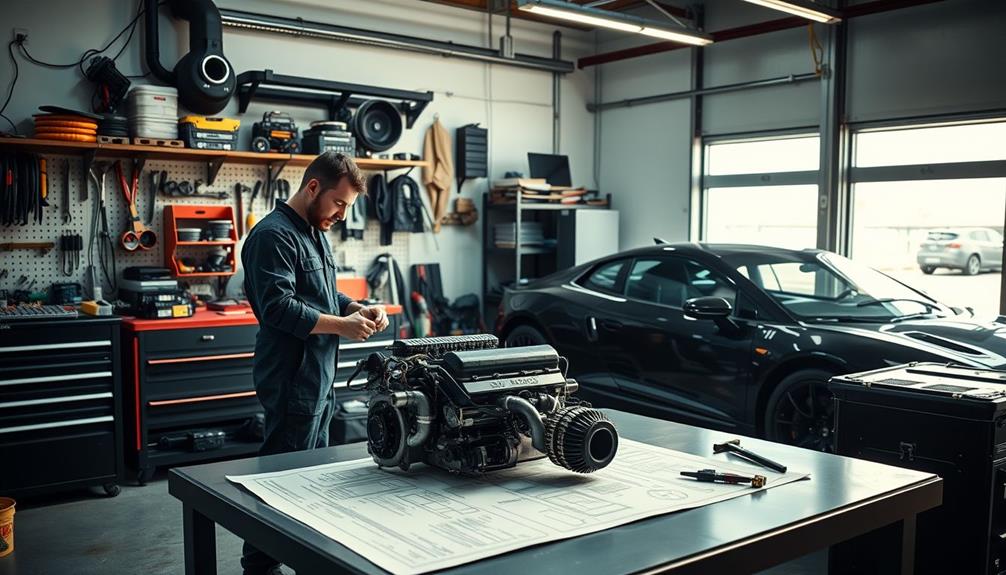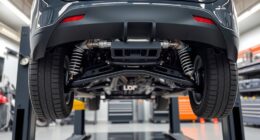Lambda is a key metric in car tuning, helping you evaluate the air-fuel mixture compared to the ideal ratio. A Lambda value of 1.0 indicates perfect combustion, while values below 1.0 point to a richer mixture, enhancing power without risking detonation. Conversely, values above 1.0 signify a lean mixture, which can lead to better fuel economy but may also affect performance. Correct Lambda measurement simplifies tuning across various fuel types, ensuring consistent results. With precise targeting, you can optimize engine performance and emissions. Keep going to discover more about how Lambda impacts your tuning strategy.
Key Takeaways
- Lambda (λ) measures the air-fuel mixture's efficiency, with a value of 1.0 indicating perfect combustion for optimal engine performance.
- A Lambda value below 1.0 indicates a rich mixture, enhancing power and preventing detonation, especially in boosted engines.
- Accurate Lambda measurements simplify tuning across different fuel types, ensuring consistent performance regardless of whether gasoline or E85 is used.
- Regular calibration of Lambda sensors is essential for maintaining precise measurements and achieving optimal combustion efficiency.
- Real-time Lambda monitoring improves tuning accuracy and enhances overall engine operation, resulting in better fuel economy and smoother driving.
Understanding Lambda and AFR
When tuning your car, understanding Lambda (λ) and Air-Fuel Ratio (AFR) is crucial for achieving ideal performance. Lambda is a dimensionless number that represents how the actual air-fuel mixture compares to the perfect stoichiometric air-fuel ratio. For pure gasoline, this ideal ratio is around 14.7:1—14.7 parts air to 1 part fuel. If Lambda is 1.0, you're hitting that sweet spot for perfect combustion in the combustion chamber.
A Lambda value under 1.0 means your mixture is rich, with more fuel than necessary, while a value over 1.0 indicates a lean mixture, with excess air. This understanding simplifies your tuning process, particularly when using various fuel types, like E85, which has a stoichiometric ratio of about 9.7:1.
Shifting from relying solely on AFR to incorporating Lambda provides a consistent measurement for combustion efficiency, making it easier to fine-tune your engine.
With Lambda, you can eliminate the confusion from variable AFRs, especially in flex-fuel applications where fuel blends frequently change. By focusing on Lambda, you can optimize your tuning for better performance and efficiency.
Importance of Lambda in Tuning

Understanding Lambda is key to effective car tuning, as it directly impacts performance and efficiency. The Lambda value tells you how your engine's air-fuel mixture compares to the ideal stoichiometric mixture. A value of 1.0 indicates ideal combustion. In performance tuning, aiming for a Lambda value of less than 1.0 guarantees a richer mixture that maximizes power and prevents detonation, especially in forced induction engines.
Utilizing a wideband sensor for Lambda measurements helps you make precise adjustments in fuel delivery. This is essential for maintaining consistent performance metrics across different fuel types without the need to recalibrate for varying air-fuel ratios.
Here's a quick reference table to illustrate the importance of Lambda in tuning:
| Lambda Value | Mixture Type | Effect on Performance |
|---|---|---|
| < 1.0 | Rich | Increased power, reduced detonation |
| 1.0 | Stoichiometric | Ideal efficiency |
| > 1.0 | Lean | Better fuel economy, risk of knock |
Lambda Calculation and Measurement

To effectively tune your car, you'll need to calculate and measure Lambda accurately.
You can do this by comparing the observed air-fuel ratio to the ideal stoichiometric ratio, which helps you understand if your mixture is rich or lean.
Using wideband oxygen sensors will give you real-time feedback, making it easier to optimize your engine's performance.
Lambda Calculation Methods
Lambda calculation methods are essential for achieving ideal air-fuel ratios in car tuning. To calculate lambda, you divide the observed air-fuel ratio (AFR) by the stoichiometric AFR for your specific fuel. For instance, if you're using gasoline, the ideal stoichiometric AFR is 14.7:1. If you find your AFR to be 12.5:1, your lambda value would be 0.85, indicating a richer mixture.
You can measure lambda using wide-band O2 sensors, which provide a broader range of AFR readings compared to narrowband sensors. Narrowband sensors only indicate whether the mixture is rich or lean, making wide-band sensors a better choice for accurate tuning.
It's also important to note that lambda calculations remain consistent across different fuel types, such as when switching between gasoline and E85, which has a stoichiometric ratio of 9.8:1.
Regularly calibrating your lambda sensor is vital for accurate measurements. Improper sensor placement or degradation can lead to inaccurate readings, affecting your tuning decisions.
Measuring Lambda Values
When tuning your car, measuring lambda values accurately is vital to achieving ideal performance. Lambda (λ) is calculated by dividing the observed air-fuel ratio (AFR) by the stoichiometric AFR specific to your fuel. A lambda value of 1.0 indicates a perfect mixture, while values like 0.85 for gasoline or 0.67 for E85 show the differences in ideal mixtures.
To measure lambda effectively, you'll need a wideband oxygen sensor, which provides real-time data on the air-fuel mixture in your exhaust gases. This dimensionless value simplifies tuning across various fuel types, making it easier to adjust your setup.
Here's a quick reference table to help you understand different lambda values and their corresponding AFRs:
| Fuel Type | Lambda Value | AFR |
|---|---|---|
| Gasoline | 0.85 | 12.5:1 |
| E85 | 0.67 | 8.3:1 |
| Stoichiometric | 1.0 | 14.7:1 |
Regular recalibration of your lambda sensors is essential to maintain accuracy. Proper placement avoids condensation, ensuring precise readings during your tuning sessions.
Practical Applications for Tuners

Understanding Lambda values is vital for tuners aiming to achieve ideal performance in their vehicles. Lambda provides a consistent measurement for air-fuel mixtures, simplifying the tuning process, especially in flex fuel applications. By targeting a Lambda value of 1.0, you guarantee peak combustion efficiency, which is essential for maximizing your engine's performance.
Here are three practical applications for using Lambda in your tuning process:
- Enhanced Accuracy: With Lambda, you can eliminate confusion from varying air-fuel ratios (AFR) that come with different fuels, such as gasoline and E85. This leads to more precise tuning adjustments.
- Peak Targets for Naturally Aspirated Engines: Aim for a Lambda target of approximately 0.83 to 0.85, which corresponds to an AFR of 12.8:1 to 13:1. This range is generally recommended for achieving the best performance from naturally aspirated engines.
- Real-Time Monitoring: Use data logging and dynamometer testing to monitor Lambda values in real-time. This practice enhances tuning accuracy and helps you achieve the desired performance outcomes effectively.
Benefits of Using Lambda

When you switch to using Lambda measurements, you gain a consistent way to evaluate performance across different fuel types.
This simplification not only speeds up your tuning process but also enhances engine efficiency by ensuring ideal air-fuel mixtures.
Consistent Performance Measurement
Lambda measurement offers a reliable benchmark for tuning your car's air-fuel mixture, ensuring consistent performance across various fuel types.
This consistency allows you to focus on enhancing your vehicle's performance without worrying about the specific fuel blend you're using.
Here are some key benefits of using Lambda:
- Accurate Tuning: With Lambda, you achieve a precise air-fuel mixture regardless of fuel type, facilitating ideal combustion and reducing emissions.
- Simplified Adjustments: Lambda maintains a constant value, eliminating the need to recalibrate for different fuels, which streamlines the tuning process, especially for flex fuel systems.
- Enhanced Performance: Shifting to Lambda-based tuning improves the engine's efficiency and performance by allowing for finer adjustments that cater to specific goals.
Simplified Tuning Across Fuels
In the world of car tuning, utilizing Lambda makes the process of adjusting air-fuel mixtures across different fuels much simpler and more effective. By targeting a Lambda value of 1.0, you can achieve a stoichiometric mixture, enhancing engine performance regardless of the fuel type. Unlike AFR, which shifts considerably with different blends, Lambda remains constant, reducing confusion during your tuning adjustments.
Here's how Lambda compares to other metrics during tuning:
| Metric | Description | Benefit |
|---|---|---|
| Lambda | Consistent air-fuel ratio measurement | Simplifies tuning across various fuels |
| AFR | Varies with fuel type | Can complicate tuning adjustments |
| 1.0 | Stoichiometric ratio | Indicates ideal combustion efficiency |
| Flex Fuel | Different blends of ethanol and gasoline | Lambda provides clarity for tuning |
| Performance | Direct correlation with combustion efficiency | Enhances overall engine operation |
Using Lambda not only streamlines your tuning experience but also eliminates the need for complex calculations when switching fuels. This metric enhances accuracy, ensuring your engine runs efficiently across varying fuel compositions.
Enhanced Engine Efficiency
Many tuners find that using Lambda markedly enhances engine efficiency.
By refining air-fuel mixtures, you can guarantee your engine runs at its best, regardless of the fuel type. A Lambda value of 1.0 indicates a stoichiometric mixture, maximizing combustion efficiency and minimizing unburned fuel emissions, which leads to cleaner exhaust.
Here are three key benefits of using Lambda in your tuning:
- Improved Throttle Response: Targeting a precise Lambda value allows for better throttle response and power output, especially in performance applications where every detail counts.
- Consistent Performance: Lambda measurements eliminate confusion surrounding varying Air-Fuel Ratios (AFR) among different fuels, making it simpler to maintain peak engine performance, particularly in flex-fuel setups.
- Enhanced Fuel Economy: Consistent Lambda tuning promotes improved fuel economy, guaranteeing your engine operates at the most efficient air-fuel mixture under varying load conditions.
Incorporating Lambda into your tuning strategy not only enhances engine efficiency but also contributes to a smoother driving experience and reduced emissions.
Challenges With Alternative Fuels

While exploring alternative fuels like E85, you'll quickly encounter challenges that can complicate car tuning. The variable stoichiometric ratio of E85, typically around 9.8:1, means that the blends at the pump can differ considerably, complicating your air-fuel ratios. Shifting between gasoline and E85 can confuse calibration, as each fuel type requires specific tuning for peak performance.
To tackle these issues effectively, consider using Lambda measurements. This metric remains consistent across different fuel types, simplifying your adjustments. In contrast, traditional air-fuel ratio (AFR) methods can yield inconsistent readings, leading to incorrect tuning decisions, especially in flex fuel systems that automatically adjust stoichiometric ratios.
Here's a quick comparison of tuning challenges with alternative fuels:
| Challenge | Impact on Tuning |
|---|---|
| Variable stoichiometric ratios | Complicates air-fuel ratio adjustments |
| Different requirements per fuel | Confusion during shifts |
| Inconsistent AFR readings | Risk of incorrect tuning decisions |
Understanding these unique challenges is vital for maximizing engine efficiency and achieving effective tuning with alternative fuels. Embrace Lambda as your guiding metric for a smoother tuning experience!
Frequently Asked Questions
What Is Lambda in Car Tuning?
Lambda in car tuning refers to the air-fuel ratio's measurement. You need to understand it to optimize your engine's performance, ensuring the right balance between fuel and air for efficient combustion and reduced emissions. Understanding lambda in car tuning is crucial for achieving the best possible performance from your vehicle. By knowing what is car tuning and how it pertains to the air-fuel ratio, you can make adjustments to your engine’s parameters to increase power and efficiency. Tuning your car’s engine allows you to customize its performance to your specific driving preferences and needs, creating a more enjoyable and responsive driving experience.
What Is Lambda on a Car?
Lambda on a car measures the air-fuel mixture's efficiency. If it's 1.0, you've got ideal combustion. Values below indicate a rich mix, while above suggest a lean mix, affecting performance, fuel efficiency, and emissions.
What Is a Good Lambda Reading?
You'll find a good Lambda reading typically between 0.83 and 0.85 for gasoline engines, which guarantees peak performance. For forced induction, aim for 0.78 to 0.80 to balance fuel and air effectively.
What Should Lambda Readings Be at Idle?
At idle, you should aim for a lambda reading around 0.83 to 0.85 for naturally aspirated engines, and 0.78 to 0.8 for forced induction setups. Deviations may indicate potential engine issues needing attention.
Conclusion
In summary, understanding lambda is vital for effective car tuning. Did you know that an ideal lambda value of 1.0 means your engine is burning fuel at the perfect air-to-fuel ratio? This balance not only boosts performance but also maximizes efficiency, reducing emissions by up to 25%. By keeping an eye on this important metric, you can guarantee your vehicle runs at its best, giving you the thrill of a well-tuned ride while being environmentally conscious.










